Excerpts from Jim Conrad's
Naturalist Newsletter
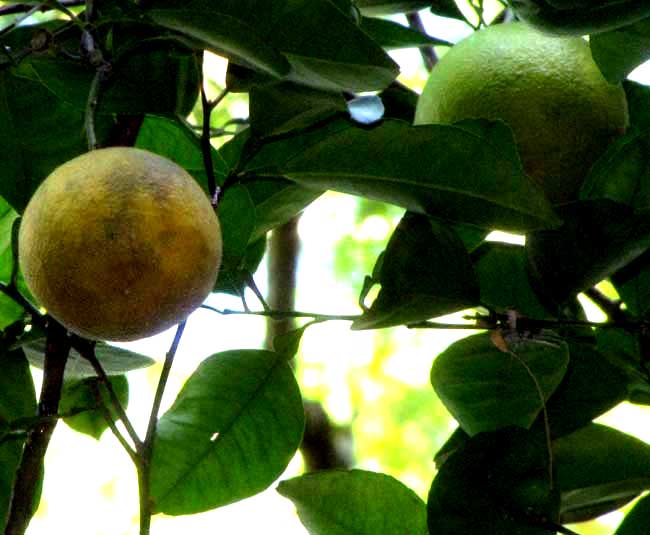
from the November 27, 2011 Newsletter issued from Hacienda Chichen Resort beside Chichén Itzá Ruins; limestone bedrock; elevation ~39m (~128ft), N20.675°, W88.569°; central Yucatán state, MÉXICO
BITTER or SOUR ORANGE
Down here it's exactly the time to enjoy eating oranges because trees in orchards are loaded with them. Fresh oranges right off the tree are sooooo sweet. People in villages generally have their own trees next to their houses and folks in larger towns often have kinfolk out in the country supplying them, so in the frutería I visit each weekend in Pisté the cost is right. I buy as many as will fit into my bags.
What I buy in Pisté is the "sweet orange," which people here call "Chinas." But right below the frutería's China bin there's a pile of what in English we call bitter or sour oranges, and sometimes I think the locals consume them even more than the sweet ones. Bitter oranges make great lemonade, plus it's nothing to see a Mexican cut one in half, salt it generously, sprinkle hot-chili powder over it, and eat it. Gringos find that remarkable because sour oranges are as sour as chili peppers are hot.
Sweet and Sour Orange trees are not just varieties of the same species; they're entirely different species. Sweet Orange is Citrus x sinensis (which agrees with the local name "China," since "sinensis" means "Chinese), and Bitter Orange is CITRUS x AURANTIUM. I find nothing bitter about bitter oranges, but my impression is that up North bitter orange is a commoner name than sour orange. Sour oranges also are called Seville oranges. Here the locals call them naranjas agrias, naranja meaning orange and agria meaning sour. You can see a couple of sour oranges at the top of this page.
A cut-open sour orange from that tree, displaying a thicker rind than most of us are accustomed to seeing on sweet oranges, and very many more and larger seeds, is shown below:
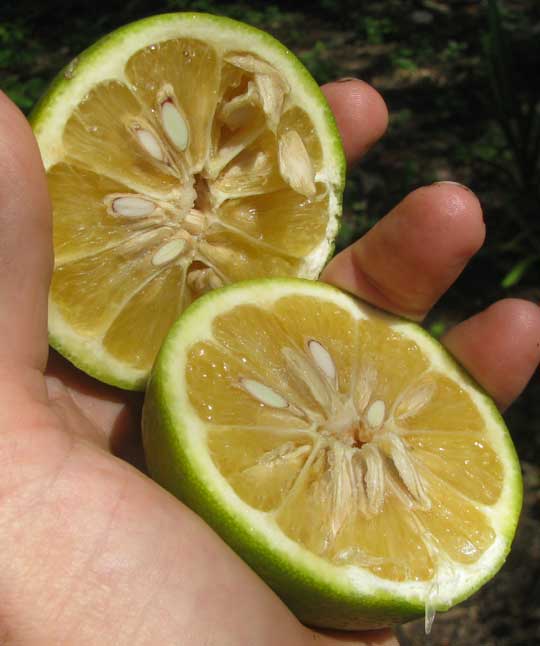
A picture focusing on the "winged petioles" of our Sour Orange tee's leaves, typical of citrus plants, is below:
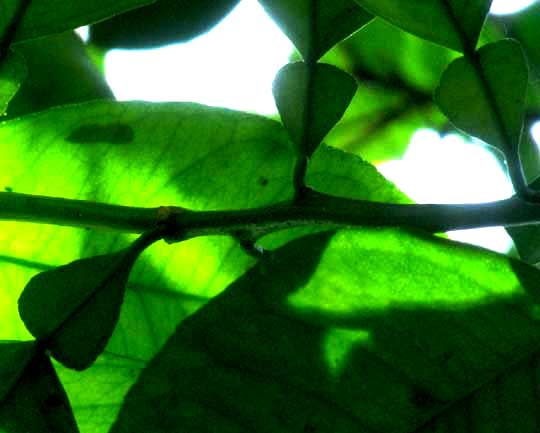
Sour Orange is native to southeastern Asia. Arabs in Arabia had it by the 9th Century. It was reported in Sicily as early as 1002, and then for 500 years it was the only orange known to Europeans. It was recorded growing here in Mexico as early as 1568. I'll bet that the Sour Oranges found in little Maya villages around us are uncontaminated by genes of later-developed varieties. I'm thinking that here we have Sour Oranges as they were 500 years ago in Europe, "the real thing."
Lots of Sour Orange varieties have been produced through selective breeding. In Japan and China they produce a "Daidai" variety prized for its flower buds, which are dried and mixed with tea for their scent. The "Paraguay" has sweet flesh. The "Vermilion Globe" is grown for its vigorous rootstock onto which sweet oranges are grafted. The "Oklawaha" produces large fruits rich in pectin and exceptionally good in marmalades. The "Bouquet" grows to only about ten feet tall (3m), produces small, brightly orange fruits, and is grown as an ornamental.
Despite the many uses of Sour Orange trees, nowadays the species is grown mainly for its rootstock onto which sprouts of other even more commercially important citrus crops are grafted. Sour Orange trees produce very vigorous root systems that do well over a wide range of soil conditions.
Until early 2011 most experts thought that Sour Orange trees constituted a regular species. However, in January, 2011 Chinese researchers who did gene sequencing studies showed that Sour Oranges, like Sweet Oranges, are hybrids of Tangerine (also called Mandarin), Citrus reticulata, and Pummelo, Citrus grandis. Since the species is a hybrid the "x" needs to be present in the binomial. You can review that paper, which also reveals the ancestry of other citrus species, here.
Good cooks are discovering Bitter Orange more every day. On a Purdue University page there's a fine survey of its uses under the heading "Food Uses" at http://www.hort.purdue.edu/newcrop/morton/sour_orange.html.
from the January 22, 2017 Newsletter issued from Rancho Regensis north of Valladolid, Yucatán, MÉXICO;
elevation ~40m (~130 ft), N~20.876°, W~88.170°
SOUR-ORANGE BLOSSOMS
Nowadays many people are upset for various reasons, so you may be glad to know that here in the Yucatan the orange trees have been blossoming -- we're at the end of their flowering period -- and the flowers' beauty and perfection have not at all been influenced by human distress and confusion.
Both Bitter Oranges and Sweet Oranges have been flowering, buds and blossoms appearing just as the last fruits of the previous season were picked, or fell after being ruined by Golden-fronted Woodpeckers. A typical Bitter Orange flower is shown below:
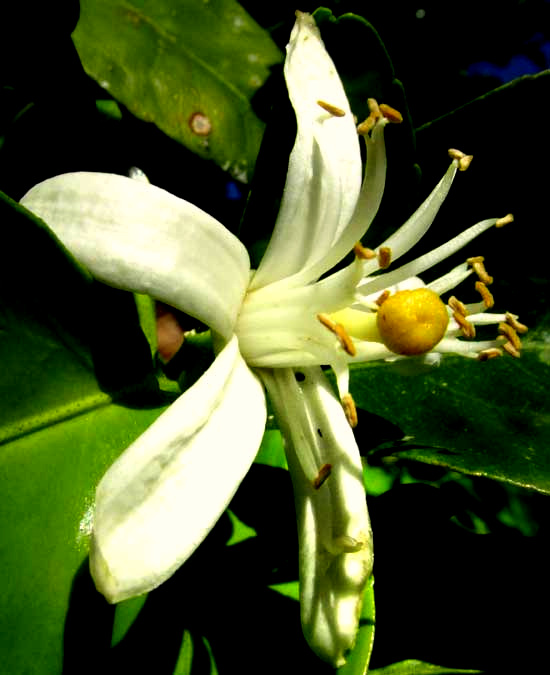
Orange blossoms are exceptionally simple in design, with the parts in the above picture being easy to make out. The five white petals do nothing fancy, just help attract a pollinator's attention in the classical way, by being bright and pretty. The ±20 out-curving, match-stick-like things are stamens -- the flower's male parts -- with the slender, white parts being the filaments and the yellowish, banana-shaped items being pollen-filled anthers. Arising from encircling filament bases is the female pistil, composed of the ovary, style and stigma. In the picture the yellow, spherical item looking like a tiny orange is the stigma, where pollen grains are supposed to germinate. The stigma is attached to the style's tip, the style being the ovary's "neck." In the picture the ovary is hidden by the filament bases. If several stamens are removed, the entire pistil can be seen, as shown below:
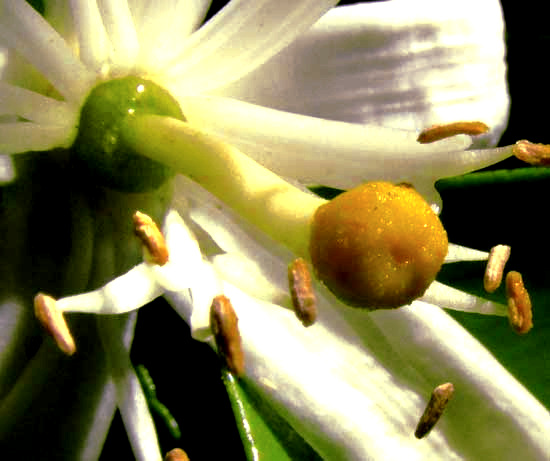
In that picture the round, shiny, green thing at the style's bottom is the ovary -- the future orange fruit. The yellow stigma looking so like a minuscule orange and the style below it will fall off not long after the flower is pollinated, leaving the tiny green ovary to begin swelling toward its days as an orange fruit.
The differences between a Bitter Orange and a Sweet Orange flower are subtle, but a feature of the leaves makes the two cultivars easy to distinguish. Some Bitter Orange leaves are shown below:
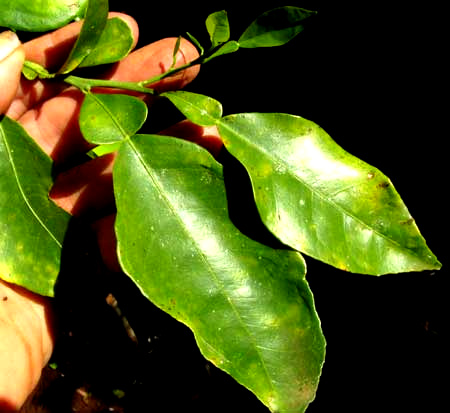
At the leaves' bases, seen in the picture's top half, notice the curious constrictions. Orange leaves are "jointed," with the outer, larger blade being the actual leaf, and the smaller part between the joint and the woody stem being a "winged petiole." The broad, flaring parts, looking so leaf-like, are the wings. On Bitter Orange leaves the wings are exceptionally wide, while on Sweet Orange leaves the wings are much narrower.
The joints between the blades and their winged petioles are such anatomical novelties that a close-up of the situation is shown below:
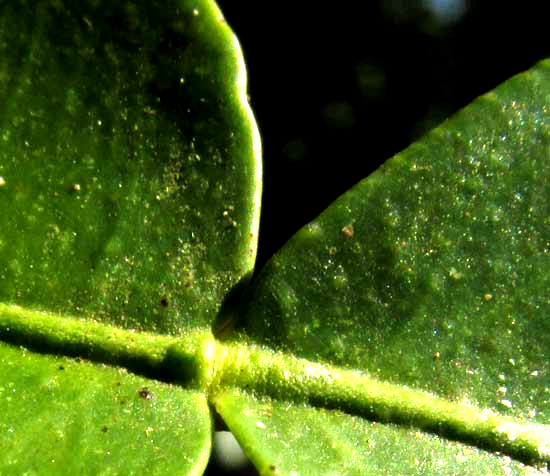
from the January 18, 2019 Newsletter issued from Rancho Regensis north of Valladolid, Yucatán, MÉXICO;
elevation ~40m (~130 ft), N~20.876°, W~88.170°
PREGNANT WOMEN AND ORANGE-PEEL SHAVINGS
While Juan was mashing his leaves of the three medicinal plants into a tooth-ache-relieving paste, I remembered something: Earlier when he'd been telling me about the great pharmacopoeia of pain-killing medicines always growing around us, he'd showed me how to scrape a kind of mealy, moist powder off the surface of a Sour or Bitter Orange, Citrus x aurantium for adding to his various pastes.
"What about the Sour Orange scrapings?" I asked as he was finishing his grinding.
"No pregnant women here," he replied.
As with most folks in this area, Juan's first language is Maya. His Spanish is a jerky, irregularly conjugated kind, so partly with words and partly with hand gestures he told me that sometimes when you pass by a pregnant woman something on the order of "bad wind" or "the evil eye" transfers from her onto you, and maybe your arm will swell up and start hurting, and that's when you need the Sour Orange scrapings.
"Lemon juice will do, too," he continued. "And we have a smaller fruit like a lemon that's the best, but it's harder to find than a lemon. Sometimes people carry that lemon-like fruit in their pockets, and that wards off the problem, too."